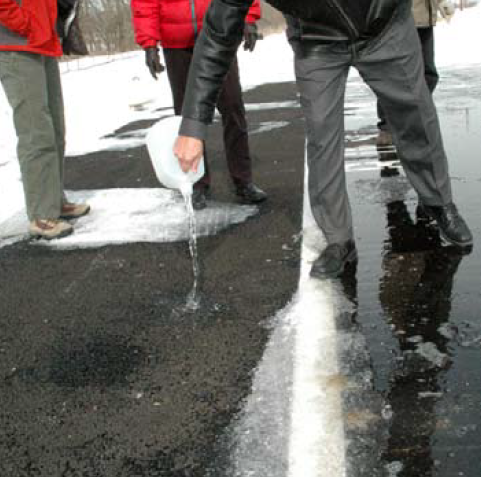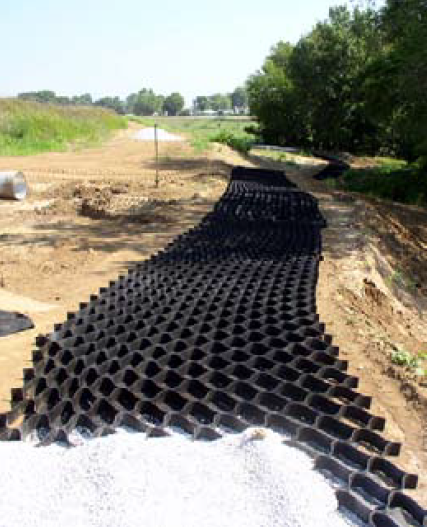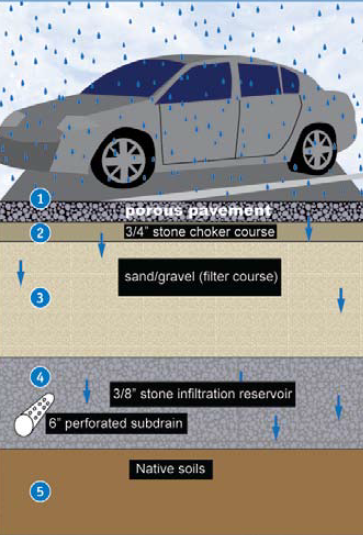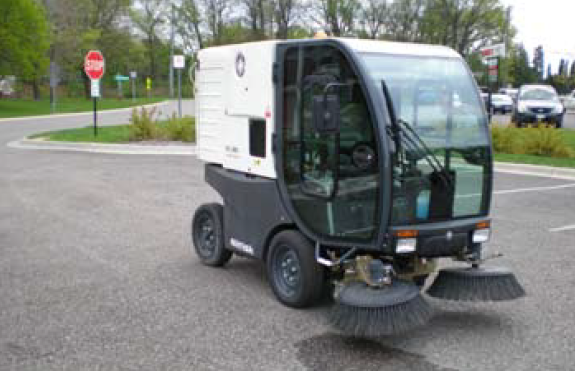Introduction
Porous pavement is one method of reducing the extent of impervious surfaces in Low Impact Development (LID) design. LID is a sustainable approach to stormwater management that minimizes impacts on waterways by controlling rainfall, snowmelt and runoff close to its source.
Porous paving systems include porous concrete and asphalt, permeable paver blocks, turf blocks and gravel pavers. They provide a sturdy surface for walking or driving while allowing stormwater to infiltrate through voids in the pavement surface. These systems generally work best in low-traffic areas, although advances in the engineering of porous pavements may make them viable substitutes for all conventional pavement applications in the future.
Porous pavement systems often require some sort of underlying engineered materials, such as sand and gravel, to provide a stable base. These permeable subbase materials also provide space for stormwater detention and, where existing native soils allow, infiltration and groundwater recharge. Porous pavements can also be installed over clay soils, but they may require an underdrain to facilitate drainage.
Local codes and ordinances can be one of the biggest stumbling blocks to the use of permeable materials in pavement design. In many municipalities, parking lots, driveways and sidewalks are required to be constructed of impermeable concrete or asphalt.
As recognition of the need to better manage stormwater grows, many communities are beginning the process of reviewing and revising their ordinances to allow for more LID features, including porous pavement.
Benefits of Porous Pavement
- DECREASES stormwater runoff
- REDUCES stormwater peak flows
- IMPROVES runoff water quality
- REDUCES flooding
- INCREASES groundwater recharge
- ELIMINATES standing water on pavement
- DECREASES pavement ice hazards and reduces need for road salting
- REDUCES thermal impacts to waterways
For a description of various Low Impact Development practices
consult the following Fact Sheets in the “Low Impact Development in Northern Nevada” series:
- LID: An Introduction, FS-09-22
- Soil Considerations, FS-09-23
- Rainwater Harvesting, FS-09-24
- Bioretention, FS-09-25
- Vegetated Swales and Buffers, FS-09-26
- Green Roofs, FS-09-27
- Plant Materials, FS-09-28
- Porous Pavement, FS-09-29
- Roadway and Parking Lot Design, FS-09-30
- Maintenance, FS-09-31
Porous concrete and asphalt
These materials appear similar to conventional impervious concrete and asphalt, but differ in the amount of fine material in the mix. Reduced amounts of fine material, sand-sized grains or finer, create void spaces that allow water to pass through the material and into a permeable subbase layer, usually composed of gravel. The sand and gravel in the subbase help to filter out pollutants before the stormwater infiltrates into the underlying soils. Both porous concrete and asphalt must be installed by experienced contractors.
These materials can be used for parking lot stalls, low- to medium-use streets, road shoulders, sidewalks, bike paths, driveways and patios. They have also been used on airport runways and highways, especially in rainy areas where flooding creates problems. When correctly installed, porous asphalt and concrete drain rapidly, reducing runoff, improving stormwater quality, helping to avoid damage from freeze-thaw cycles and improving public safety by reducing ice on pavements.
Because porous asphalt looks very similar to standard asphalt, care must be taken to prevent it from being chip-sealed, which will hinder infiltration. Roadway maintenance crews must be notified of the specific locations that should not be chip-sealed.

The porous asphalt on the left rapidly infiltrates water and decreases icy winter road surfaces. The standard impermeable asphalt on the right allows snowmelt to pond and then freeze at night. Image by USDA-NRCS.
Permeable pavers
Permeable pavers fall into two main groups: brick or concrete pavers and open-celled grid pavers. Brick or concrete pavers are typically set into a base of leveled sand. An underlying gravel subbase can be added to provide additional stability and stormwater detention. Where underlying soils allow infiltration, such as in native sandy soils, stormwater runoff and snowmelt infiltrate through the pavers and sand to the gravel subbase and continue into the underlying soil. Brick and concrete pavers come in a variety of shapes, sizes and colors and are sometimes designed to interlock. They are attractive and relatively easy to install and can be retrofitted into an existing landscape.
Open-celled unit pavers are typically made of recycled plastic or concrete and are designed as grid networks that are filled with soil, sand or gravel to form a flat surface. They can be planted with seed or turf. Open-celled unit pavers allow infiltration of stormwater while maintaining a surface that supports vehicles. They work well in overflow parking areas, driveways and sidewalks. Open-celled unit paver systems can also be retrofitted into an existing landscape. The flexibility of the grid pavers makes them appropriate for use on uneven or sloping terrain.
Pavers must be carefully installed to avoid uneven surfaces as they settle. For this reason, pavers may be a poor choice for handicapped parking areas and walkways. Design the subbase layers to bear appropriate loads for the intended use. For example, parking a vehicle requires greater load-bearing capacity than a bicycle path, sidewalk or walkway.

Open-celled unit pavers form the base for this graveled walking trail. Image by USDA-NRCS.
Limitations on the use of porous pavement
All forms of porous pavement work best in fairly flat areas with slopes of less than 5 percent. They are not recommended for areas where the seasonal high groundwater table is less than 3 feet below the bottom of the gravel subbase. They should not be used in areas where highly contaminated runoff may infiltrate the porous pavement, including gas stations and hazardous materials storage or processing facilities, unless an impermeable liner and an underdrain system are included in the design. When installed in areas where road sand is used in the winter or where there are regular inputs of sediment, such as near an eroding slope, clogging may occur.
It is best to install porous asphalt or concrete or permeable pavers at the end of the construction phase or as a retrofit, to minimize exposure to sediment and potential clogging.

Permeable pavements often incorporate layers of sand and gravel or rock that hold and infiltrate runoff into the underlying soils. Image by USDA-NRCS.
Performance in cold climates
Many questions have arisen about the longevity of porous pavement in cold climates. Researchers, including those at the Stormwater Center at the University of New Hampshire, have studied these stormwater treatment systems for several years. They found that a well-drained porous pavement system will have a longer life cycle due to reduced freeze-thaw susceptibility and greater load-bearing capacity than conventional parking lot pavements (Gunderson, 2008).
Because these systems effectively infiltrate snowmelt and keep roads dryer, sand and salt applications can be minimized. Researchers found that winter maintenance of porous asphalt required 25 percent less salt to provide the same level (or better) of de-icing and traction (UNHSC, 2007).
Researchers also found that the composition and depth or thickness of the subbase materials made a difference in stormwater storage capacity and treatment efficiency. They added a sand filter layer to the typical layer of coarse rock and achieved increased filtration. The purpose of the subbase is two-fold: to support vehicles and to store and treat water. The subbase should be designed so that water drains rapidly after storms end. When placed over clay or silty soils, an underdrain can be added to facilitate drainage. An impermeable liner can also be included in the design when infiltration is not desired, for example, at locations where native soils are expandable clays, in areas of shallow groundwater, next to building foundations, or where spills of hazardous materials are likely to occur.
A system constructed in Pennsylvania in 1983 as part of the Shared Medical Systems headquarters consisting of a series of porous pavement parking bays connected by conventionally paved roadways continues to function well after 20 years (Adams, 2003). It had not been repaved, despite problems with sinkholes that had caused pavement problems prior to installation of the porous pavement.
These systems hold great promise for adding stormwater infiltration into paved surfaces.

In areas with poor soils and high groundwater, rain passes through the porous asphalt (1) and choker course (2), and pollutants are filtered out in the filter course (3). Water is stored in the reservoir (4). Any excess water flows out through the subdrain (4) if infiltration into native soils (5) is not possible. Image by University of New Hampshire Stormwater Center.
Maintenance
Porous pavement should be monitored several times a year as well as after storm events to make sure infiltration is occurring and pores have not been clogged with sand or other sediments.
- Vacuum-type street cleaners should be used at least twice a year on porous road surfaces, driveways and parking stalls.
- Sweep and vacuum pavers on a regular basis with street cleaners that combine suction with sweeping.
- It may be necessary to use flamers or other tools to suppress weeds between pavers.
- Avoid the use of chemical weed killers, which can contaminate water.
- Turf installed in the open cells of grid unit paving systems will require the same type and amount of maintenance as all other turf areas, including irrigation, mowing and weeding. The aggregate layer in open-celled pavers can be replaced as needed if it becomes clogged or contaminated.
- In open-celled unit pavers, grid segments should be replaced when three or more adjacent rings are broken or damaged.

Regular maintenance with vacuum-style street cleaners is needed to keep porous road surfaces functioning. image by John Bilotta.
References:
- Adams, M.C., 2003, Porous Asphalt Pavement with Recharge Beds 20 Years and Still Working, Stormwater Journal, Vol. 4, No. 3.
- Brzozowski, C., 2009, Permeable Pavers, Part 1: Choosing products and installation methods, Stormwater Journal, September 2009.
- Gunderson, J., 2008, Pervious Pavement: New findings about their functionality and performance in cold climates, Stormwater Journal, September 2008.
- University of New Hampshire Stormwater Center (UNHSC), 2007, Porous Asphalt, in 2007 Annual Report, UNH.
For additional detailed planning and design information
refer to the latest versions of the Truckee Meadows Low Impact Development Handbook and the Truckee Meadows Structural Controls Design Manual available at TMS.
Technical review provided by Chris Conway, Certified Professional in Sediment and Erosion Control.
Additional information about porous pavements can also be found at:
- University of New Hampshire Stormwater Center.
- Stormwater Manager’s Resource Center, SMRC.
- Toolbase Services.
- U.S. Environmental Protection Agency, Storm Water Technology Fact Sheet, Porous Pavement.
- University of Connecticut NEMO, Planning for Stormwater, Permeable Pavement.
- Interlocking Concrete Pavement Institute, ICPI.
Donaldson, S.
2009,
Low Impact Development in Northern Nevada: Porous Pavement,
Extension | University of Nevada, Reno, FS-09-29


